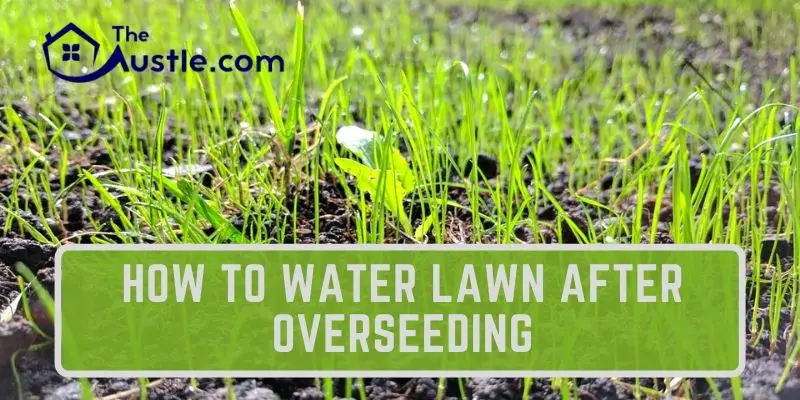Want to know how to water lawn after overseeding. Then, this article is for you.
A beautifully green lawn is a symbol of pride. It is a pleasant place to relax or play.
But maintaining a green lawn requires some special care. It needs a lot of water because there may be merely low water levels for much of the year.
Watering your grass seed is a very simple process. It requires daily investment. By proper watering, you find a lush green lawn you have always wanted.
How To Water Lawn After Overseeding
Watering your lawn may seem natural, but proper watering has a little more science behind it.
We will give you some expert tips on how to water lawn after overseeding. By following this, you can have a beautiful garden. Check below:
Step: 1
After overseeding your lawn, it needs consistent moisture. The soil must keep moist by lightly sparkling. You must water your garden two or three times daily throughout the necessary germination period.
Step: 2
Once your seed germinates, water less frequently but allow for deeper soaking. Water encourages better root growth. You must be careful that not to soak the soil repeatedly because it helps root rot diseases.
Step: 3
When the grass grows, the soil allows drying slightly before watering again. Because overwatering and soaking the ground, causes root rot problems. On the other hand, underwatering causes dry out the tiny roots.
Step: 4
If there is raining a lot, you do not need to water your lawn. But you must check that how much rain your yard is getting from nature, when nature alone is not enough, then you water your lawn.
Step: 5
Frequent watering and daily observation are essential. When the new seed is drying out during the day or night, another watering is added in the midway between the two.
Step: 6
If you’re watering your grass and not a vegetable or fruit garden, you may want to consider recycling water. In this case, rainwater is safe to use because it is naturally watering your yard.
Why You Need Watering
- Seed requires moisture for germination.
- Water maintains proper soil temperature.
- Dry spells cause poor germination.
- Mature roots need water to survive.
Best Time For Watering
After overseeding, proper watering helps to seed germination. For getting the best result to follow these:
- Before germination, waterless but more frequently. In every location, water 15-20 minutes two to three times per week.
- For the first week, water three times a day, especially in the morning to mid-morning, noon and mid-afternoon.
- For four to five weeks, water more but less frequently. In every location, sprinklers 45-60 minutes three times per week.
- For five to nine weeks, water once or twice per week.
Seed germinates within two or three weeks. It depends on the soil and watering methods. Sometimes you find small weed seed grow along with the grass, so you should remove them at an early stage.
How Much To Water After Overseeding
Your lawn soil is always soaked in the root zone. That means soaking your ground to the depth up to 3 inches deep.
You must check it by digging up a small core and see how far down the water has reached into the soil. Monitoring should be done after 24 hours of watering.
Equipment To Use
For better lawn, you should use the right equipment. You can use the hose, water cans or sprinkler. The sprinkler is the most effective tool because it gives a constant soaking.
You also make sure that you have enough hose to reach out everywhere in your lawn.
Working With Professional
Professional lawn care is critical to make your lawn evergreen all around the year. When you are watering your lawn, the lawn care company can also work with you. They give you the guideline about how to water your grass seed. They can also advise you whether your lawn is getting enough water or not.
Some Tips
- Overwatered grass has the same symptoms as the water needed lawn. You can tell the difference by noticing the soil condition. If it is damp, you need to water less, or if it is dry, you need to water more.
- Some grass can survive in drought condition. So long as the dry period is followed by a period of recovery.
- Local extension services or water conservation authorities provide additional information on how to water your lawn more effectively. They can offer other techniques to save water.
- Weeds not only take up space in your yard but also compete for water and nutrients in the soil. So you pull up weeds and be sure that you dig deep enough to remove the entire root system.
Warnings
Do not water your lawn at night or late in the evening because it promotes an environment for fungus and disease.
Conclusion
Irrigation your land effectively and keep your lawn always evergreen. It would be best if you watered your area according to the soil type and climatic conditions.
So, read the article carefully and follow the instructions on how to water lawn after overseeding. We think you find all of your inquiry in this article.
- How To Change The Blades On A Bad Boy Mower
- How To Stop Neighbors Grass From Growing Under Fence
- How To Apply Potash To Lawn
- How To Cut Grass Around Sprinkler Heads In Your Lawn
- How To Get Bermuda Grass Out Of Zoysia
- How To Properly Load A Bobcat On A Trailer
- How To Remove PTO Clutch On Grasshopper 721d

